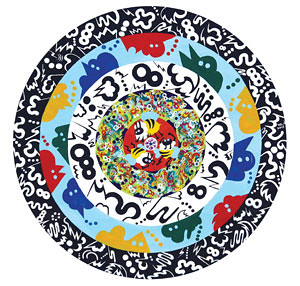A team of local and international artists are transforming Kathmandu into the second mural city in the world

PICS: CINDREY LIU
For decades the white washed wall linings of Kathmandu have fought a losing battle against layers and layers of political slogans and posters. Yuki Poudyal, the brains behind
Kolor Kathmandu, along with Sattya Media Arts Collective (see box), however, are on a mission to replace the sea of red letters and give the battered walls of this city a much needed facelift.
“Kathmandu’s residents have been treated to visual pollution all their lives. I wanted to change this by making our streets more appealing through mural art,” says the 27-year-old project director who was inspired by street art in Philadelphia (see interview).
With 12 international muralists including popular German street artist duo, Herakut, and 25 local artists, Kolor Kathmandu has painted 25 murals in Baluwatar, Shankhamul, Bhotahiti, Jawalakhel, and other parts of town so far. They receive Rs 7,000 each for their hard work. The goal, says Yuki, is to create 75 murals by September and name them after the 75 districts of Nepal.
While some artists have focused on landscapes, others have chosen to depict social stigmas and problems faced in their districts. Anish Bajracharya’s Bara in Bhanimandal for example pays homage to the popular Newari lentil dish which shares its name with the district and also incorporates the Gadhimai festival held in Bara every five years.
Along with resuscitating the Valley’s sick walls, the project is nurturing young talents and providing them an opportunity to learn from veterans. First-timers are asked to shadow an experienced artist, after which they can submit their designs. Once their plans are approved, they can lead their own mural. Eighteen-year-old Sangrachana Chamling is one such aspiring talent who assisted an international artist before creating her own mural at Sanepa.
As the popularity of the murals spreads through word of mouth, support for the project is gaining steam. When Kolor Kathmandu posted a request for aluminum ladders on its Facebook page, there were plenty of takers. Recently Pashupati Paints agreed to provide supplies for the artists. Not to miss out on the fun, people living outside Kathmandu have been asking Kolor Kathmandu to come paint their home towns.
“It’s great to see the artists’ efforts being appreciated,” says Yuki, “but they created the murals not for themselves or for Sattya. The art belongs to the neighbourhoods. We want people to be inspired and take ownership and protect it as their own.”
Kolor Kathmandu, a gallery by Cindrey Liu.
A brush with street art
Project director Yuki Poudyal tells us her vision for Kolor Kathmandu.
Nepali Times: How did Kolor Kathmandu start?
Yuki Poudyal: When I lived in Philadelphia, I was amazed by the amount of art that filled the city. The paintings and graffiti brought a sense of positivity to the community and inspired me to do something similar in Kathmandu. Nepal is fragmented at so many levels, but art is one way to show our unity. And this is why we are creating 75 murals to represent each district.
Was it difficult to get funds?
Surprisingly, money wasn’t a big problem. Sattya is supported by Open Society Foundations, a grant-making organisation based in New York and we also receive funding from Prince Claus Fund of Netherlands.
Why did you choose mural art?
We didn’t want to create art that would only be displayed at galleries and exhibitions. This is our way of reaching out to a larger Nepali public and saying we will not stand and see our city get more damaged than it already is.
Finding places to paint has been the biggest challenge so far. We have a team of volunteers who go around town searching for locations, but sadly people still see street art as vandalism and are not very accepting. For most murals we ask for permission from owners or whoever is in charge, but with some we just go ahead and paint.
Do you think politics and art can go together?
There is so much filth in Nepali politics these days. It is constantly abused by those in power. Only if we can clean up our politics can art become a part of it.
GROWING ART
Started in 2009 by Anya Vaverko and Yuko Maskey,
Sattya today is a hub for artists, photographers, filmmakers, and writers. “We wanted a place in Kathmandu where creative people could connect, learn from one other, and share their ideas,” says Anya.
The media arts collective regularly organises photography, documentary making, graphic designs, and screen printing workshops. Along with supporting Kolor Kathmandu, Sattya holds free screening of documentary films and discussions in public places around the Valley – aptly called Bato Ko Cinema - as well as teaching urban farming and ways to create green spaces in a congested Kathmandu through its Hariyo Chowk project.
The making of a mural by Priscila De Carvalho